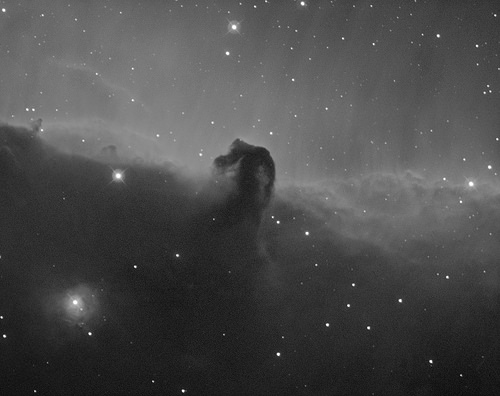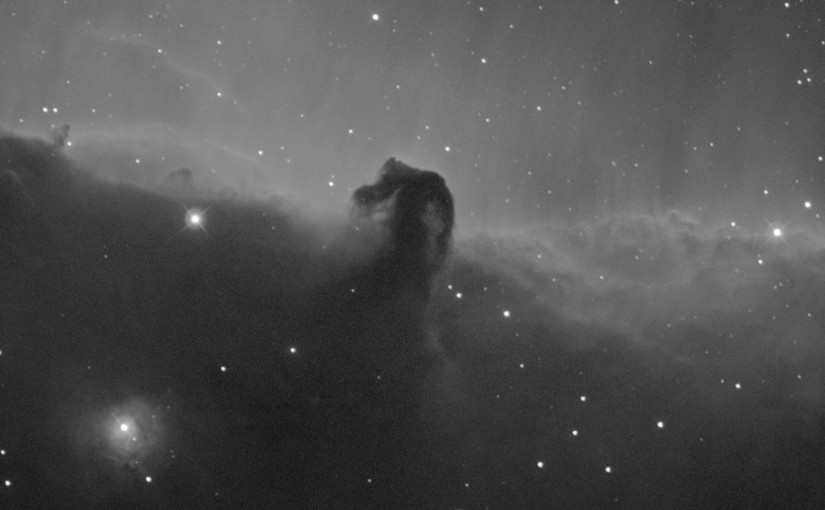B33 – The Horsehead Nebula
Imaging opportunites have been few and far between this autumn. Whenever it has been clear there has been a bright Moon, it has been too windy or I’ve been busy. But at last we had a clear night with no Moon and I could finally image something!
 My choice was the Horsehead Nebula in Orion. An object I’ve not imaged before. The Horsehead is a famous dark nebula (Barnard 33) shaped like a horse’s head which is silhouetted in front of a huge bright emission nebula (IC 434 or Sh2-277) known as the Flame Nebula. The whole complex surrounds Alnitak which is the lefthand star in the distinctive line of three stars that make up the Belt of Orion. The Horsehead is found just below Alnitak.
My choice was the Horsehead Nebula in Orion. An object I’ve not imaged before. The Horsehead is a famous dark nebula (Barnard 33) shaped like a horse’s head which is silhouetted in front of a huge bright emission nebula (IC 434 or Sh2-277) known as the Flame Nebula. The whole complex surrounds Alnitak which is the lefthand star in the distinctive line of three stars that make up the Belt of Orion. The Horsehead is found just below Alnitak.
I imaged using my QHY22 camera and a H-alpha filter. This filter only transmits light from a specific deep-red visible spectral line. This light is emitted when a hydrogen electron falls from its third to second lowest energy level. H-alpha light is interesting to amateur astronomers as it’s emitted by emission nebula and local light pollution (even moonlight) won’t interfere with the imaging. By imaging using a H-alpha filter you can get great images of nebulae with high contrast. The payoff is that you need long exposures (typically 5-15 minutes each) and for that you need really good auto-guiding.
Auto-guiding involves using a second telescope mounted in parallel to the imaging telescope with a second camera taking continuous short exposures (typically 1-2s long). Using a clever bit of software the position of a ‘guiding star’ on each exposure is compared to the previous and if it has moved due to errors in the telescope tracking the rotation of the Earth the software automatically applies a correction to the position of the telescope so that the star remains exactly in the same place whilst you are imaging. Without guiding you are limited to shorter exposures of around one minute each as the errors in tracking add up and the stars will start to trail slightly.
My guiding setup has been working really well since I set up the Starshed Enterprise and I can usually get five minute exposures with no visible star trailing. To reduce noise in the resulting image you need to stack as many exposures as you can get and I typically aim for a minimum of 20 exposures. Twenty exposures of five minutes each is around two hours of imaging including taking dark frames for calibration.
It’s preferable to get all of the imaging done before the object crosses the meridian (due South) as although you can continue imaging for a while afterwards eventually the telescope tube will hit the mount and you have to perform what is called a ‘Meridian Flip’. This involves re-pointing the telescope from the eastern hemisphere to the western hemisphere and is a bit of a faff. On this evening I started early enough and the Horsehead was far enough east that I didn’t need to perform a flip for two hours worth of imaging.
In the end I managed to get 19x300s exposures. I had to stop as the secondary mirror was completely dewed up (a bit like how a bathroom mirror steams up after a shower). I could have cleared it with a quick blast from a 12V hairdryer but the whole observatory was dripping with dew and it was close to flip time so I packed up. I need to experiment with heaters or fans to prevent dewing up of the secondary as it has been a bit of a pain.
Capturing, stacking and processing was all done in Nebulosity 3. The resultant image is still a little bit noisy (grainy) but I’m pretty pleased with the result. I plan to capture some more exposures at some point to improve the image further. I might even be able to take some of the surrounding area and create a mosaic image as the nebulosity stretches way beyond the field of view of my setup.
